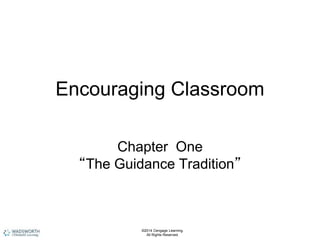
Chapter1 The Guidance Tradition
- 1. Encouraging Classroom Chapter One “The Guidance Tradition” ©2014 Cengage Learning. All Rights Reserved.
- 2. Chapter One Guiding Questions : • Who were the pioneers of the guidance tradition? • 2. Who were mid-20th-century influences in the guidance tradition? • 3. What was the significance of discipline trends in the 1980s? ©2014 Cengage Learning. All Rights Reserved.
- 3. Chapter One Guiding Questions : • 4. What is the state of the guidance tradition today? • 5. Cultural Responsiveness: How does guidance relate to cultural diversity? • 6. Family Partnerships: What is the importance of parent–teacher relations in the guidance tradition? ©2014 Cengage Learning. All Rights Reserved.
- 4. Early Pioneers • John Comenius (1592-1670) – The desire to learn can be excited by teachers, if they are gentle and persuasive and do not alienate their pupils from them by roughness. Rods and blows should never be used in schools. • Johann Pestalozzi (1746-1827) – Teachers need to look first at the system if there are behavioral problems. Positive behavior is a natural outgrowth when children are involved in engaging activities that meet their needs. • Robert Owen (1771–1858) – Punishment is never required, and should be avoided as much as giving poison in their food. Teachers are to use kindness in tone, look, word, and action. ©2014 Cengage Learning. All Rights Reserved.
- 5. Early Pioneers • Friedrich Froebel (1782-1852) – The teacher should see the natural impulses of the child not as a tendency toward evil but as the source and motivation for human development that with guidance leads to character in the adult. • Maria Montessori (1870–1952) – The child is in a process of dynamic development, which the adult has attained. Children educate themselves through absorption in meaningful tasks. In this process they learn both self-discipline and responsible decision making. • John Dewey (1859–1952) – Out of the occupation, out of doing things that are to produce results, and out of doing these things in a social and cooperative way, there is born a discipline of its own kind and type. ©2014 Cengage Learning. All Rights Reserved.
- 6. Mid-20th-Century Influences • Jean Piaget (1896-1980) – The modern ideal is cooperation—respect for the individual and for general opinion as elaborated in free discussion. Children come to this spirit of democracy through the modeling of cooperation by adults who are able to make autonomous (intelligent and ethical) decisions themselves. • Alfred Adler (1870-1937) – Healthy development of the child results in an adult ability for interconnectedness with social groups, to the benefit of both society and the individual. Guidance that is encouraging without being permissive or dictatorial is central, leading to adults able to actualize their individual and social potentials. ©2014 Cengage Learning. All Rights Reserved.
- 7. Mid-20th-Century Influences • Self Psychologists (1960s-1970s) – The developing self is the dynamic in human behavior. Schools must address not just academics, but also the self-concepts of learners. Students experiencing successful involvement in education feel positively about themselves, have little need to act out, and are able to engage in significant learning. • Rudolph Dreikurs (1897-1972) – Teachers need to be leaders, not bosses. When their attempts to achieve social acceptance fail, children show antisocial behavior for a purpose, to achieve any of four mistaken goals. Teachers should use techniques such as encouragement and logical consequences instead of punishment to help the child find social acceptance. • Haim Ginott (1922-1973) – The “psychology of acceptance” means that the teacher’s task is to build and maintain positive relations with each child. The teacher uses techniques such as “I” messages, the “cardinal principle” (address the behavior, accept the child), and nonjudgmental acknowledgment to support relationships and solve problems. ©2014 Cengage Learning. All Rights Reserved.
- 8. Discipline Trends in the 1980s • Emphasis on academic programming with younger children lent itself to tightly controlled classrooms (Elkind). • Obedience-based disciplines – Effects on children: humiliation, stigmatism, ‘winners’ and ‘losers’ – Effects on teachers: reduced ability to use professional judgement – Effects on parents: discourages involvement in school if parent disagrees with policy • Keeping guidance alive: – Early childhood education – Conflict resolution movement • Developmentally Appropriate Practice (DAP) ©2014 Cengage Learning. All Rights Reserved.
- 9. Guidance Practice Today • Guidance means teaching children to learn from their mistakes, rather than punishing children for making mistakes. • A guidance approach teaches children democratic life skills—the skills individuals need to function as productive citizens and healthy individuals in a diverse society. ©2014 Cengage Learning. All Rights Reserved.
- 10. Guidance Practice Today • Democratic life skills in a diverse society include the ability to: – see oneself as a worthy individual and capable member of the group. – express strong emotions in nonhurting ways. – make decisions ethically and intelligently. – work cooperatively in groups to recognize and resolve common problems. – be understanding of human qualities and characteristics in others. ©2014 Cengage Learning. All Rights Reserved.
- 11. Parent-Teacher Relations • Positive parent-teacher relations contribute at a fundamental level to the success of the guidance approach. – Froebel—mothers should take leadership in organizing kindergartens – Montessori—teachers as model for children and parents alike – Child study movement—nursery schools administered by parents – Head Start—home visits, classroom volunteering – Public schools—individual relationships between teachers and parents for those with older children, ECFE for those with younger kids ©2014 Cengage Learning. All Rights Reserved.
